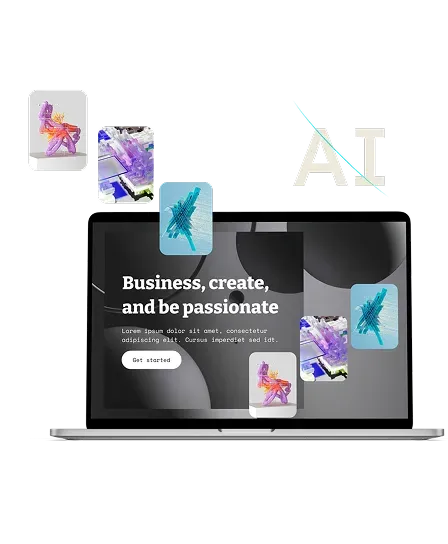
Ecommerce overhaul: ai and computer vision in a bi platform
24%
conversion rate boost
46%
enhanced user data collection
4X
improved NPS

Challenge
Sustaining e-commerce revenue surge by effectively utilizing vast customer data with transformative BI technology.
Solution
Robust retail BI platform leveraging computer vision and AI algorithms to streamline processes, elevate product discovery, and enhance the UX.
Client
Our valued client is an esteemed e-commerce company operating in the home goods and furniture industry. They offer placement on their website and app to over 11,000 suppliers who have collectively uploaded more than 14 million items to the platform. Recognizing the changing landscape of customer preferences and expectations influenced by technology, the client embarked on a mission to revolutionize their offerings. Their vision involved creating an intelligent Business Intelligence (BI) platform that would utilize the power of AI and computer vision. The primary objective was to enhance product discovery and offer personalized recommendations to their customers. By embracing these cutting-edge technologies, our client aimed to drive customer engagement, increase sales, and optimize pricing strategies.



Challenge
Amidst the ever-evolving landscape of global e-commerce, our client, an international company, experienced a remarkable surge in revenue during the pandemic. However, as time progressed, they faced the challenge of sustaining this level of success while effectively utilizing the vast amount of customer data they had accumulated. Recognizing the need for a transformative solution, they turned to BI technology.
The goal was clear: streamline processes, make informed decisions, and elevate both product discovery and the overall customer experience. To achieve this, the client set their sights on a robust solution—a unified BI platform that would harness the power of computer vision algorithms. By employing these algorithms, the platform would be able to analyze and categorize product images, simplifying the search for visually similar items. Additionally, they sought to leverage AI algorithms to provide personalized recommendations and optimize pricing strategies based on customer preferences and market trends.After receiving a glowing recommendation from a satisfied past customer, our client selected Modsen as their software vendor for the development of their retail BI platform. They were impressed by our extensive expertise in e-commerce and business intelligence, making us the perfect partner to transform their vision into a reality.
Got a similar software development project on your mind?
Estimate a precise timeframe for its implementation.
Team
1
Team leader
1
Project manager
1
Business analyst
1
Data analyst
1
Solution architect
1
DevOps engineer
2
Data engineers
2
BI engineers
5
Software Engineers
1
UX/UI designer
4
QA engineers

Process
1 Initiating
In the initial phase of the project, we formed a dedicated team consisting of a Project Manager, Business Analyst, and Technical Architect. Each member brought their unique expertise to the table, ensuring a well-rounded and capable group to spearhead the project. To facilitate smooth communication and collaboration, Modsen established clear channels of communication between our team and the client. This open line of communication allowed for seamless exchanges of information, feedback, and updates, fostering a transparent and cooperative working environment. In addition, we set realistic deadlines and defined a budget framework to guide the project’s progress. This approach ensured that our activities stayed on track, met established timelines, and adhered to the allocated budget, enabling effective project management and resource allocation. The initiation phase laid a solid foundation for the project, assembling the right team, establishing clear communication channels, and providing a structured framework for successful project execution.

2 Discovery
Through close collaboration with the client, Modsen embarked on the Discovery Phase, delving deep into gathering requirements, analyzing the market and target audience, and gaining a comprehensive understanding of the project scope and potential limitations. This meticulous discovery process formed a solid foundation, ensuring that all key aspects were documented and the client’s needs were fully grasped. Armed with the gathered information, our team set out to design a BI solution that precisely addressed the requirements while leveraging our expertise in AI algorithms and computer vision techniques. This design phase involved meticulous consideration of the technical aspects, carefully mapping them to the documented requirements to ensure a seamless alignment with the project goals.

3 Planning
During the planning phase, Modsen invested significant effort in mapping out the project plan to ensure alignment with the client’s objectives. We understood the importance of setting a clear direction right from the start, which allowed us to establish a solid foundation for the project’s success. Our team collaborated closely with the client to gain a comprehensive understanding of their objectives, requirements, and desired outcomes. Through thorough discussions and meticulous analysis, we identified key milestones, deliverables, and timelines that would guide the project’s progression. Modsen paid careful attention to incorporating the client’s input and feedback into the planning process, ensuring that their vision and expectations were fully taken into account. By aligning our plan with their goals, we fostered a sense of partnership and ownership in the project. Additionally, the team considered potential challenges during the planning phase. Our proactive approach enabled us to develop contingency strategies and mitigation plans, allowing for smoother project execution and timely problem resolution.


4 Development process
Building a robust and scalable infrastructure:
After considering the project’s requirements, we strategically determined that leveraging Azure and Kubernetes (k8s) would be the most advantageous approach for the infrastructure. By adopting Azure as our cloud computing platform and implementing Kubernetes for container orchestration, our development team successfully achieved the desired scalability, fault-tolerance, and auto-scaling capabilities for the solution. This decision resulted in reduced idle time, optimized infrastructure costs, and efficient resource allocation, aligning with the client’s objectives and ensuring a robust and scalable infrastructure for the project.
Architecture: design and implementation:
A meticulous design and implementation process was undertaken to ensure that the solution’s architecture not only met the defined requirements but also exceeded expectations. Starting with a comprehensive analysis of the project requirements, our skilled architects collaborated closely with the client to identify the optimal architectural approach. Drawing upon our deep expertise in e-commerce and retail BI, we crafted a scalable and robust architecture that could accommodate the anticipated growth and evolving needs of the client. The architecture leveraged cutting-edge technologies and best practices to provide a solid foundation for the solution. We carefully considered factors such as data processing and storage, security, performance, and integrations with existing systems. The design phase involved detailed system diagrams, component specifications, and workflow mappings, ensuring a clear and comprehensive understanding of the solution’s architecture.
Project development process

With the design finalized, our experienced development team executed the implementation process with meticulous attention to detail. They meticulously translated the architectural blueprint into a functional reality, adhering to industry standards and following best practices every step of the way. Rigorous testing and quality assurance measures were employed to ensure the stability, reliability, and performance of the solution. At every stage of the development process, including the architecture phase, Modsen prioritized open and ongoing communication with the client. Regular updates were provided, and their input was actively sought to ensure that our work consistently aligned with their vision and goals. This collaborative approach fostered trust and transparency, allowing for agile iterations and timely adjustments as required throughout the entire development journey. The result was a well-architected solution that seamlessly integrated with the client’s existing infrastructure, effectively leveraging AI algorithms, computer vision techniques, and other cutting-edge technologies to deliver optimal performance and exceptional user experiences.
Code implementation and QA:
Our development team embraced the Agile Scrum methodology, ensuring efficiency and flexibility throughout the project. They divided the development cycle into two-week sprints, working collaboratively to transform the design specifications into functional code. Carefully selecting the most suitable technologies and programming languages, they leveraged a range of tools to achieve the desired functionality and performance.
To deliver high-quality code, our developers adhered to industry best practices and coding standards. Thorough code reviews and automated testing frameworks were employed to detect and rectify any potential issues or bugs, maintaining the stability and reliability of the solution.
By adopting the Agile Scrum methodology, the team demonstrated their commitment to delivering a high-quality solution within the specified timeline. The incremental development approach fostered transparency and trust, providing the client with visibility into the progress at each stage.
Furthermore, quality assurance was a priority throughout the project. Our dedicated QA engineers conducted ongoing performance testing on the deliverables to ensure the BI platform adhered to the highest standards of performance. This rigorous testing allowed us to identify stability issues and critical defects within the components. Prompt resolution of these issues improved the overall performance, stability, and reliability of the solution.
To maintain a stable and timely delivery process, we embraced continuous integration and delivery (CI/CD) practices. This involved continuous code review and quality assurance, ensuring seamless development and integration.
The result of the code implementation phase was a robust and scalable solution. The clean and well-structured codebase facilitated future maintenance and enhancements, allowing for seamless scalability and adaptability as the client’s business requirements evolved. Modsen's commitment to quality assurance and CI/CD practices ensured the delivery of a high-performing solution that met the client’s expectations.
Streamlined deployment:
The Agile Scrum methodology remained instrumental in guiding our team during the project’s deployment phase. We followed two-week sprint cycles, which ensured a systematic and efficient deployment process. Throughout each sprint, our engineers collaborated closely to package and deploy the BI platform incrementally. Breaking down the deployment process into manageable chunks minimized the risk of disruptions and facilitated quick iterations.
To guarantee a smooth transition from development to production, our team leveraged industry-standard deployment tools and techniques. Thorough testing and quality assurance checks were conducted at every stage of the deployment process, ensuring the solution's stability and reliability.
Furthermore, Modsen worked closely with the client’s IT department to seamlessly integrate the solution into their existing infrastructure. Any compatibility issues or technical hurdles were promptly addressed, facilitating a successful deployment.
By adhering to the Agile Scrum methodology and following industry best practices, our team successfully deployed the solution in a timely and efficient manner. The incremental and iterative approach allowed for continuous improvement and real-time adjustments, ensuring that the e-commerce BI platform evolved to meet the client’s evolving needs.
Iterative demonstrations:
Additionally, the regular demos provided the client with a visual representation of the solution’s development journey, allowing them to witness its functionality and potential firsthand. This iterative approach ensured that any concerns or modifications could be promptly addressed, keeping the project on track and aligned with the client’s expectations. By following Agile methodology and conducting these demos, we fostered a collaborative environment where both our team and the client actively participated in the project’s evolution. The open and transparent exchange of information during the demos built a sense of trust and partnership, as the client had visibility into the progress and had the opportunity to provide valuable feedback.
Integration with third-party solutions and tools:
As part of the development process, Modsen seamlessly incorporated a range of third-party solutions and tools into the platform, enhancing its capabilities and extending its functionality. Noteworthy partnerships included: Adobe Campaign: By integrating with Adobe Campaign, the platform gained access to advanced marketing automation and campaign management features. The solution empowered the client to deliver personalized and targeted marketing campaigns, maximizing customer engagement and driving business growth. Criteo: The collaboration with Criteo, a leading digital advertising platform, enabled the client to leverage powerful retargeting and display advertising capabilities. This integration expanded the platform’s reach, effectively targeting potential customers and increasing conversion rates. Qualtrics: By integrating Qualtrics, a robust customer experience management platform, the client obtained valuable insights into customer satisfaction, feedback, and sentiment analysis. These insights gave the client opportunity to refine their products and services based on real-time customer feedback, enhancing overall customer experience and loyalty. Dynamic Yield: Through the successful partnership with Dynamic Yield, an AI-powered personalization platform, the client could deliver highly personalized and tailored experiences to their customers. Advanced algorithms and machine learning dynamically optimized content, recommendations, and offers based on individual user preferences and behaviors, increasing engagement and driving conversions. These strategic partnerships enriched the platform’s functionality, equipping the client with industry-leading solutions and tools. By seamlessly incorporating these third-party providers, Modsen ensured that the platform delivered an exceptional user experience and helped the client achieve their business objectives.
Third-party audit and product certification:
Modsen recognized the importance of ensuring the quality, reliability, and security of the developed product. To achieve this, the platform underwent a rigorous third-party audit. Independent experts thoroughly evaluated the technology and security aspects of the solution, assessing its compliance with industry standards and best practices. The audit covered various areas, including data protection, system architecture, code quality, and vulnerability testing. The successful completion of the third-party audit resulted in the product certification, providing assurance to the client and end-users that the platform adheres to stringent quality and security standards.
Acceptance testing:
Before finalizing the project, Modsen conducted comprehensive acceptance testing in collaboration with the client. This testing phase aimed to validate that the developed solution met all specified requirements and functioned as expected. Working closely with the client, a series of test scenarios were designed to cover various use cases and simulate real-world scenarios. The client actively participated in the acceptance testing, providing feedback and verifying that the solution aligned with their expectations. By conducting thorough acceptance testing, Modsen ensured that the product delivered a seamless user experience and met the client’s objectives.
5 Exit
The solution developed by Modsen leverages computer vision algorithms to analyze and tag product images, making it easier for customers to find visually similar items. The client’s BI platform also employs AI algorithms to offer personalized recommendations and optimize pricing strategies based on customer preferences and market trends.
Project in production
Upon successful completion of the project, Modsen supported the client in the transition to the operational phase. This involved providing the necessary guidance and assistance to ensure a smooth handover of the solution to their internal teams. Modsen’s experts worked closely with the client, offering training sessions, knowledge transfer, and comprehensive documentation to facilitate the successful adoption and utilization of the developed solution.
Code and documentation
As part of the exit process, Modsen delivered the complete source code of the developed solution to the client. This allowed the client to have full ownership and control over the codebase, enabling them to make future modifications, enhancements, and maintenance as needed. Additionally, comprehensive technical documentation, including architecture diagrams, database schemas, and API documentation, was provided to assist the client’s technical teams in understanding and maintaining the solution effectively. The business analyst’s documentation, such as functional specifications, requirements documents, and user stories, was also handed over to ensure the client had a thorough understanding of the solution’s business context.
User guide
To facilitate seamless user adoption, Modsen prepared a comprehensive user guide for the developed solution. This guide provided detailed instructions, step-by-step procedures, and best practices to help end-users effectively utilize the platform’s features and functionalities. The user guide aimed to empower the client’s users by providing them with the necessary knowledge and guidance to maximize the benefits of the solution. The exit phase marked the successful completion of the project, with the client equipped with the necessary resources, knowledge, and support to independently manage and leverage the developed solution.
- Enhanced Product Discovery: Customers could easily find visually similar products, resulting in improved product discovery and a more engaging shopping experience.
- Improved Customer Satisfaction: Personalized recommendations based on individual preferences increased customer satisfaction and fostered long-term customer loyalty.
- Increased Sales And Revenue: The BI platform’s personalized recommendations and optimized pricing strategies led to higher conversion rates and increased sales. By understanding customer preferences and market trends, the client was able to offer targeted promotions and pricing, maximizing revenue.
- Operational Efficiency: The automated image analysis and tagging capabilities reduced manual efforts in product categorization and improved the speed and accuracy of product updates on the platform. This streamlined workflow allowed the client’s team to focus on other critical business tasks.
- Competitive Advantage: By leveraging AI and computer vision technologies, the client gained a competitive edge in the e-commerce market. The platformэs advanced capabilities differentiated their brand and positioned them as a leader in providing personalized and visually appealing shopping experiences.
- These indicators demonstrate the successful implementation of the AI and computer vision-powered BI platform and its impact on various aspects of the client’s business. The numbers associated with these indicators further validate the positive outcomes:
Solution highlights
The solution developed by Modsen leverages computer vision algorithms to analyze and tag product images, making it easier for customers to find visually similar items. The client’s BI platform also employs AI algorithms to offer personalized recommendations and optimize pricing strategies based on customer preferences and market trends.
1. Computer vision for image analysis and tagging

One of the primary objectives was to enhance product discovery by enabling customers to find visually similar items easily. Modsen developed a computer vision system capable of analyzing and tagging product images based on various attributes such as color, style, pattern, and shape. The platform simplified the search process and provided customers with accurate recommendations by automatically extracting and categorizing these features.
2. AI-powered personalized recommendations
The BI platform has integrated advanced AI algorithms to provide personalized recommendations to customers. By leveraging historical data, user behavior patterns, and purchase history, the system generates tailored product suggestions, thereby enhancing cross-selling and upselling opportunities. Through continuous learning from customer interactions, the AI models improve their recommendations over time, resulting in higher customer satisfaction and increased sales.
3. Pricing optimization strategies
To stay competitive in the market, the client required dynamic pricing strategies that could adapt to changing customer preferences and market trends. Modsen’s development team incorporated AI algorithms into the BI platform to analyze market data, competitor pricing, and customer demand patterns. By leveraging this information, the platform optimized pricing strategies in real-time, ensuring that prices remained competitive while maximizing profit margins.
Results and impact
The implementation of the AI and computer vision-powered BI platform had a significant impact on the client’s business:
Enhanced Product Discovery:
Customers could easily find visually similar products, resulting in improved product discovery and a more engaging shopping experience.Improved Customer Satisfaction:
Personalized recommendations based on individual preferences increased customer satisfaction and fostered long-term customer loyalty.Increased Sales And Revenue:
The BI platform’s personalized recommendations and optimized pricing strategies led to higher conversion rates and increased sales. By understanding customer preferences and market trends, the client was able to offer targeted promotions and pricing, maximizing revenue.Operational Efficiency:
The automated image analysis and tagging capabilities reduced manual efforts in product categorization and improved the speed and accuracy of product updates on the platform. This streamlined workflow allowed the client’s team to focus on other critical business tasks.Competitive Advantage:
By leveraging AI and computer vision technologies, the client gained a competitive edge in the e-commerce market. The platform`s advanced capabilities differentiated their brand and positioned them as a leader in providing personalized and visually appealing shopping experiences.
These indicators demonstrate the successful implementation of the AI and computer vision-powered BI platform and its impact on various aspects of the client’s business. The numbers associated with these indicators further validate the positive outcomes:

24%
Increase in conversion rate46%
Expanded user data collection4x
Higher net promoter scorePS: Future expansion and improvements
The successful implementation of the BI platform laid a strong foundation for the client’s future growth. To further enhance the platform and stay ahead in the rapidly evolving e-commerce landscape, the following areas of future expansion and improvement are considered:
- Augmented Reality (AR) integration: Incorporating AR capabilities into the platform can allow customers to visualize products in their own space, increasing their confidence in making purchase decisions.
- Voice and natural language processing (NLP): Integrating voice and natural language processing technologies can enable customers to interact with the platform using voice commands or text-based queries, providing a more seamless and intuitive user experience.
- Advanced analytics and predictive modeling: Expanding the AI capabilities of the platform to include advanced analytics and predictive modeling can provide deeper insights into customer behavior, market trends, and inventory management, enabling the client to make data-driven decisions.